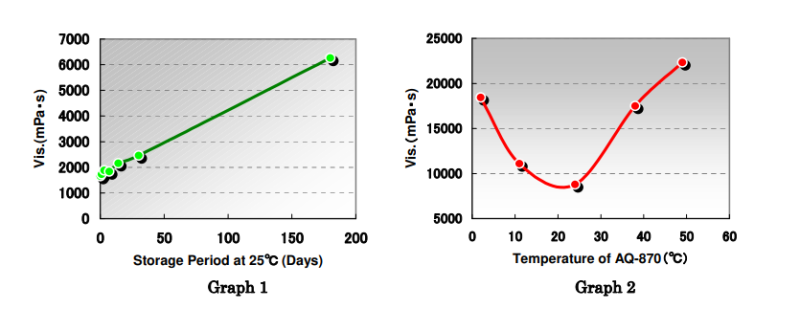Knowde Enhanced TDS
Identification & Functionality
- Chemical Family
- CASE Ingredients Functions
- Technologies
- Product Families
Features & Benefits
- CASE Ingredients Features
- Advantages
- Excellent anti-settling property
- Imparts high thixotropic property without excess viscosity increasing
- Easy incorporation
Applications & Uses
- Applications
- Coating Type
- Use Level
- 1 - 6 wt. % (Total Formulation)
- Applications
DISPARLON AQ-870 can be used in a wide range of waterborne coating systems.
Properties
- Physical Form
- Appearance
- Yellow liquid
- Typical Properties
| Value | Units | Test Method / Conditions | |
| Active Matter | 15 | wt.% | — |
| Amine | N, N-dimethylethanolamine | — | — |
| Acid Value | 9.1 | — | — |
| Solvent | Water /2ethylhexylalcohol | — | — |
Technical Details & Test Data
- Instruction
Product’s Viscosity
The viscosity of this product gradually increases during storage (Graph 1), and is temperature depending (Graph 2). Storage at around 25°C is recommended to get lower viscosity.

Flow property
At low temperature (below 10°C), this product loses the fluidity and becomes paste form. In this case, heat at 50°C or more for about 24 hours to fluidize it again.
Storage (days) 0 1 3 7 14 30 Viscosity at 0°C (mPa.s) 1656 min. 10000 min. 10000 min. 10000 Not flowable Not flowable Viscosity at 10°C (mPa.s) 1656 4190 4310 4750 5720 7620 Viscosity at 20°C (mPa.s) 1656 2220 2300 2450 2670 3070 *Brookfield Viscometer
Storage & Handling
- Storage Conditions
- Keep from freezing. Freezing causes degradation of quality and performance.
- At low temperature (below 10°C), this product loses the fluidity and becomes paste form. In this case, heat at 50°C or more and fluidize again before use.

